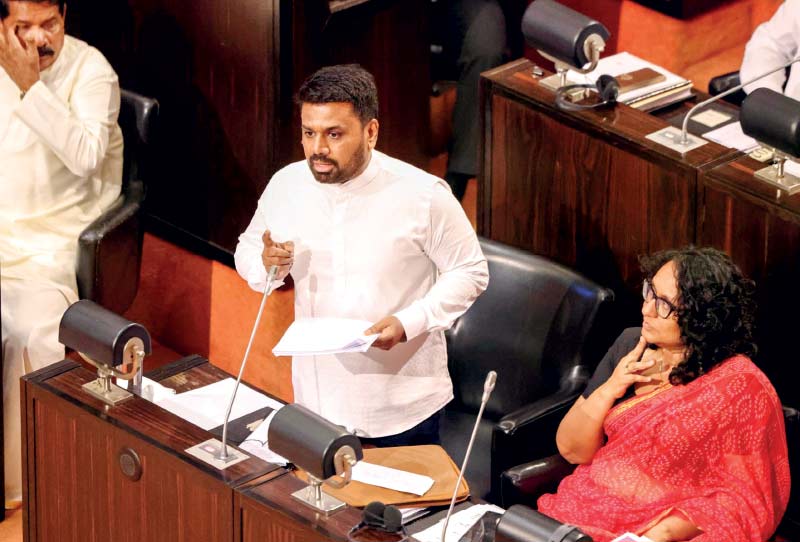Wednesday Nov 12, 2025
Wednesday Nov 12, 2025
Wednesday, 12 November 2025 00:19 - - {{hitsCtrl.values.hits}}

President and Finance Minister Anura Kumara Dissanayake
 By locking in fiscal consolidation while redirecting expenditure toward high-impact, productivity-enhancing projects, the Government aims not only to recover the economic output lost during the crisis but also to place Sri Lanka on a fundamentally stronger, more resilient, and technology-driven path. Its success will now depend entirely on efficient, transparent execution—a challenge the budget seeks to mitigate through its own commitment to digital governance and zero tolerance for corruption. In short, along with the 2026 Budget, President AKD is heading in the right direction to reach “A thriving Nation and a Beautiful Life”
By locking in fiscal consolidation while redirecting expenditure toward high-impact, productivity-enhancing projects, the Government aims not only to recover the economic output lost during the crisis but also to place Sri Lanka on a fundamentally stronger, more resilient, and technology-driven path. Its success will now depend entirely on efficient, transparent execution—a challenge the budget seeks to mitigate through its own commitment to digital governance and zero tolerance for corruption. In short, along with the 2026 Budget, President AKD is heading in the right direction to reach “A thriving Nation and a Beautiful Life”
 Introduction: The pivot to productive equilibrium
Introduction: The pivot to productive equilibrium
President Anura Kumara Dissanayake’s Budget 2026, presented on 7 November, signals a clear shift from crisis management to strategic economic transformation. The main message is that fiscal consolidation and inclusive development are not opposing priorities but essential, interconnected elements for long-term national resilience.
The Budget successfully navigates the challenging dual mandate of meeting international fiscal requirements (IMF targets) while urgently addressing domestic welfare and infrastructure needs. Macroeconomic targets are clear: the deficit is set at 5.2% of GDP, and the debt-to-GDP ratio is projected to fall to 95% by 2026, anchoring stability. Simultaneously, growth is aggressively targeted at 7% annually through investment and productivity-led expansion.
The balance is evident in the allocations: major investments in digital infrastructure, healthcare, and education lay the groundwork for a knowledge economy, while significant financial packages for housing, rural roads, and public servant benefits directly inject relief and opportunity into the grassroots economy. By linking fiscal discipline with radical reforms—such as anti-corruption measures and digital governance—the budget attempts to build a moral and financial environment conducive to sustained, equitable prosperity.
Anchoring stability: Fiscal discipline and macroeconomic ambition
The Budget 2026 fundamentally commits to a stable fiscal trajectory, essential for maintaining investor confidence and concluding the nation’s debt restructuring efforts. This section focuses on the rigorous fiscal targets and revenue-enhancing reforms designed to ensure long-term sustainability.
The continuation of the IMF-backed fiscal consolidation program is non-negotiable, targeting a primary surplus and reducing the Debt-to-GDP ratio to 95% by 2026, with a further ambitious reduction to 87% by 2030. Revenue mobilisation is central to this effort, with state revenue expected to climb to 15.3% of GDP by 2026.
Key tax reforms are introduced for clarity and compliance:
Furthermore, the introduction of a competitive bidding system for Government procurement alongside the launch of E-procurement and digital asset management systems in 2026 is a critical structural reform. These measures are not just cost-saving; they are vital anti-corruption tools that eliminate irregularities and ensure that public funds are utilised efficiently, thereby enhancing the productivity of public expenditure. This disciplined financial framework provides the platform for the Government to launch its growth initiatives.
The digital leap: Productivity, governance, and future growth
A cornerstone of the 2026 Budget is the realisation that long-term growth is inextricably linked to technological modernisation and institutional efficiency. The proposed digital reforms are designed to eliminate systemic corruption, improve service delivery, and create a high-value Virtual Economic Zone.
Allocations in this area focus on creating a streamlined, transparent Government
apparatus.
The shift to fully digital Government payments is pivotal, reinforced by eliminating fees for QR transactions below Rs. 5,000 to drive mass adoption. The commitment to issuing Digital ID cards by March 2026 provides the crucial underlying technology for efficient, targeted service delivery and resource management.
Crucially, investment is channelled into innovation and connectivity:
This digital focus is a clear growth accelerator, positioning Sri Lanka’s economy for modern, export-oriented services and laying the foundation for a significant increase in overall factor productivity.
Investing in human capital: Health, education, and social equity
The Budget achieves its development mandate through substantial, targeted allocations to strengthen the social safety net and build future human capital. By ensuring social protection, the Government secures the social license required for structural economic reform.
Key allocations for human development include:
Furthermore, the increase in the Mahapola Scholarship by
Rs. 2,500 provides direct support to students, reinforcing access to higher education, a fundamental pillar of future economic productivity. These measures represent a clear developmental focus that protects the vulnerable and invests in the long-term quality of the national workforce, ensuring that the fruits of economic growth are shared equitably.
 President Dissanayake’s Budget 2026 is a pragmatic and ambitious blueprint that successfully balances the imperatives of Economic Growth and Development. It moves beyond the short-term transactional politics of past budgets by embedding core values—fiscal discipline, anti-corruption, and equity—into the nation’s financial architecture
President Dissanayake’s Budget 2026 is a pragmatic and ambitious blueprint that successfully balances the imperatives of Economic Growth and Development. It moves beyond the short-term transactional politics of past budgets by embedding core values—fiscal discipline, anti-corruption, and equity—into the nation’s financial architecture
Revitalising core economic sectors: Infrastructure and production
To ensure the projected 7% economic growth is realised, the Budget commits significant capital to core production and connectivity sectors. This investment focuses on both massive long-term projects and grassroots, productivity-boosting initiatives.
1. Infrastructure as a growth catalyst:
2. Boosting local production:
These investments are critical levers that translate fiscal stability into tangible economic output, generating jobs and securing the foundational requirements for national growth.
Socio-economic upliftment: Wages, housing, and public service reform
The final key element of the balanced Budget is its direct impact on citizen welfare and the structural improvement of public services—a critical step in enhancing overall governance and social harmony.
1. Public sector morale and efficiency:
2. Housing and grassroots relief:
These focused social and structural reforms ensure that the stabilisation gains are not achieved at the expense of the working class but are instead utilised to foster a more inclusive and socially resilient economic environment.
 This Budget is the pivot from rescue to resurgence. Fiscal discipline is now the fuel, not the burden, driving a decisive shift toward digitalisation and equitable growth. It is a blueprint that trades austerity for lasting, productive prosperity
This Budget is the pivot from rescue to resurgence. Fiscal discipline is now the fuel, not the burden, driving a decisive shift toward digitalisation and equitable growth. It is a blueprint that trades austerity for lasting, productive prosperity
Conclusion: A blueprint for resilient and inclusive prosperity
President Dissanayake’s Budget 2026 is a pragmatic and ambitious blueprint that successfully balances the imperatives of Economic Growth and Development. It moves beyond the short-term transactional politics of past budgets by embedding core values—fiscal discipline, anti-corruption, and equity—into the nation’s
financial architecture. The simultaneous commitment to a 7% growth target via major infrastructure and digital transformation, alongside deep, structural investments in health, education, and social welfare, demonstrates a coherent strategy. This budget understands that a healthy, educated, and well-connected populace is the greatest asset for a production-led economy.
By locking in fiscal consolidation while redirecting expenditure toward high-impact, productivity-enhancing projects, the Government aims not only to recover the economic output lost during the crisis but also to place Sri Lanka on a fundamentally stronger, more resilient, and technology-driven path. Its success will now depend entirely on efficient, transparent execution—a challenge the Budget seeks to mitigate through its own commitment to digital governance and zero tolerance for corruption. In short, along with the 2026 Budget, President AKD is heading in the right direction to reach “A thriving Nation and a Beautiful Life”.
(The writer, among many, served as the Special Advisor to the President of Namibia from 2006 to 2012 and was a Senior Consultant with the UNDP for 20 years. He was a Senior Economist with the Central Bank of Sri Lanka (1972-1993). He can be reached via [email protected].)